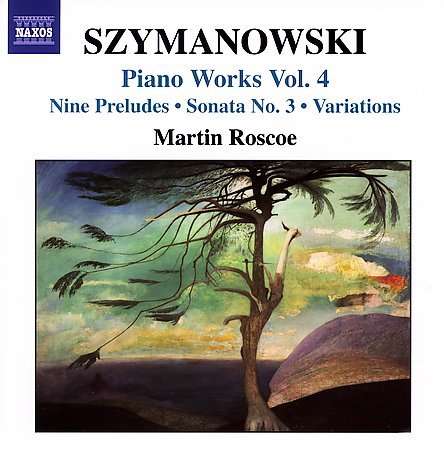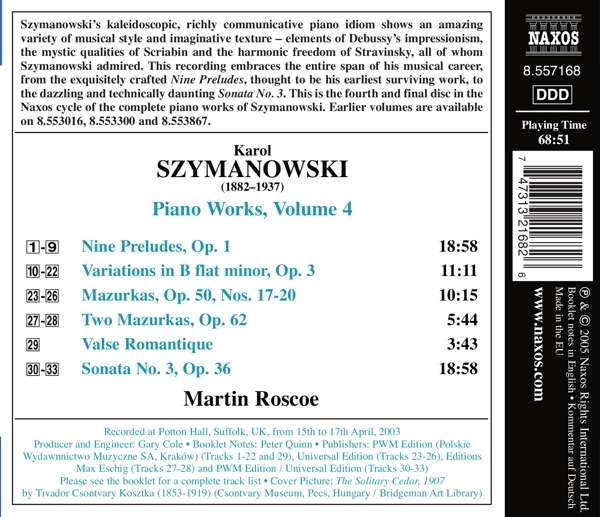
kompozytor
Szymanowski, Karol
tytuł
SZYMANOWSKI: Piano works vol. 4
wykonawcy
Roscoe, Martin
nr katalogowy
8.557168
opis
Szymanowski’s Nine Preludes, Op. 1, contain what is thought to be his earliest surviving works. The seventh and eighth of the set were composed in 1896 when the composer was only fourteen. All nine of these vignettes are exquisitely crafted and possess an uncommon melodic beauty. •
Composed between 1901 and 1903, the Variations in B flat minor, Op. 3, remain quite strongly bound to classical formal principles, with the variations generally adhering to the phrase structure of the theme. The variations are characterized by an incredible variety of mood and texture, from the hymnic simplicity of the eighth variation to the virtuosic perpetuum mobile of the concluding twelfth variation, and from the wistful mazurka of the third variation to the serene waltz of the ninth. •
The twenty Mazurkas, Op. 50, were composed in Zakopane in 1924-25 and were published in five sets of four. The influence of the Góral folk-music of the Tatra mountains can be discerned throughout, characterized by sharpened fourths and flattened sevenths, melodic ornamentation, irregular phrase lengths, and the use of the so-called dudowa kwinta, a reiterated open fifth that recreates the drone effect of the dudy, the Polish bagpipes. •
Szymanowski’s final return to the mazurka came at the end of his life. The Two Mazurkas, Op. 62, were composed in 1933-34 and were his last completed works. One of the very few extant recordings of Szymanowski is his performance in 1933 of the first of these mazurkas, a piece he was especially fond of. •
The delightful, if all too brief, Valse Romantique was composed in 1925 as a tribute to Emil Hertzka on the occasion of Universal Edition’s 25th anniversary. Only discovered in 1967, its harmonic language offers perhaps the most overt display of Szymanowski’s Francophile sensibilities. •
Szymanowski completed his Sonata No. 3, Op. 36, in 1917. His last major work for piano, it is cast in a single continuous movement while at the same time embracing the four conventional subdivisions of the orthodox sonata: a dynamic first movement notable for its elevation of the second subject to a position of thematic precedence, an elegiac slow movement in ternary form in which whole-tone harmonies predominate throughout, a short yet metrically adventurous scherzo and a dazzling and technically daunting fugal finale, at the climax of which the first movement’s second subject returns in seamless combination with the fugal subject.
nośnik
CD
gatunek
Muzyka klasyczna
producent
Naxos
data wydania
17-10-2005
EAN / kod kreskowy
747313216826

(Produkt nie został jeszcze oceniony)
cena 58,00 zł
lubProdukt dostepny w niewielkiej ilości.
Wysyłka w ciągu 3 dni roboczych
Darmowa wysyłka dla zamówień powyżej 300 zł!
Darmowy kurier dla zamówień powyżej 500 zł!
sprawdź koszty wysyłki







































